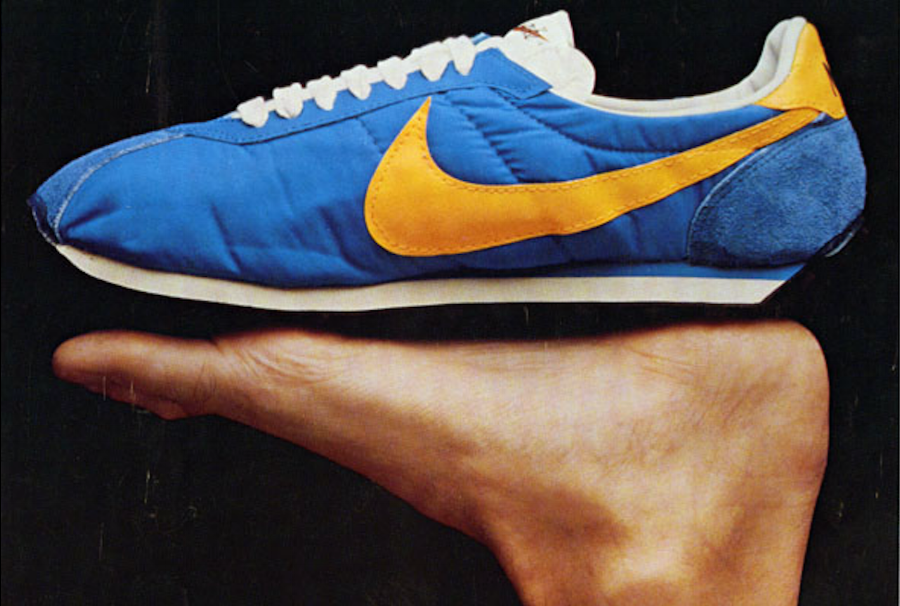When the track surrounding University of Oregon’s Hayward Field was transitioning from cinder to an all-weather urethane surface in 1970, a renowned track and field coach named Bill Bowerman was presented with a challenge: finding shoes for his athletes that could grip equally well on synthetic surfaces as grass. Unable to locate the model he wanted on the market, Bowerman, who had been actively tinkering with sneaker designs for years, co-opted – and as the story goes, ruined – his wife’s waffle-iron one morning in an attempt to create perfectly grooved rubber for a new lightweight sneaker sole that would perform on a number of different surfaces.
The mold that Bowerman conceived in his kitchen that morning would go on to inspire the Portland-based sportswear giant’s first-ever running sneaker, the Waffle trainer. Bowerman “thought running shoes could be better,” Nike’s first full-time employee Jeff Johnson says about the his early innovations, including the Waffle. “He challenged accepted notions of traction, cushioning, biomechanics and even of anatomy itself.”
According to Nike, Phil Knight – who joined with Bowerman in January 1964 to found Blue Ribbon Sports, what the global giant now know was Nike was first called – would become Bowerman’s guinea pig, the first student-athlete to try many of Bowerman’s originals. It was not long before the ground-breaking Waffle sneaker got prime-time placement, though.
Blue Ribbon Sports had to move quickly. It had nylon uppers flown in from Japan to pair with Waffle soles hand-cut from sheets of rubber made in Eugene. Geoff Hollister, an early Blue Ribbon Sports employee, hand-glued the components together, creating shoes for the Blue Ribbon Sports crew to debut at the 1972 U.S. Olympic track and field trials in Eugene, Oregon.
The hand-built shoes were initially dubbed the Moon Shoe, a reference to the distinctive imprint they made in the dirt, which resembled the lunar footprints left behind by American astronauts during the era’s historic Apollo missions, but Bowerman refined the concept and the iconic Waffle trainer was born.
The Waffle, with its intricately-raised, gridded pattern and grip traction, hit the market in 1974, and Nike has since sold tens of millions of pairs. More than that, according to Nike, the Waffle was what put it “on the global athletic footwear map, setting the stage for unparalleled growth.”
In addition to racking up numbers in terms of units sold, accolades – such as the title of “the shoe that launched a billion-dollar athletic empire” – and honors, including residence in the National Museum of American History, as a gleaming example of how individuals and shoe companies started experimenting with improved designs in the 1960’s and 70’s, Nike has amassed an array of exclusive rights in the shoe, an important step towards enabling the company to build an empire – and a monopoly – on that shoe.
In the world of footwear, where the competition is fierce and the R&D involved tends to be wildly expensive, obtaining legal protections is critical.
For the Waffle trainer (and most other Nike models), the process of protection began almost right away. In 1972, as soon as he had finished the final prototype, Bowerman applied for a patent for it. The description was for “an athletic shoe suitable for use on artificial turf, including an improved upper of a porous multiple layer construction and an improved sole having integral polygon shaped studs … of square, rectangular or triangle cross section, having a plurality of flat sides which provide gripping edges that give greatly improved traction.”
The patent (No. 3,793,750) was granted on February 26, 1974, and Nike had the green-light to begin producing the Waffle trainers en masse.
Nike’s patent rights in the original Waffle trainer have since expired, due to the limited duration of the monopoly that comes with patent protection, but the sportswear giant maintains other rights in the innovative sneaker. It can almost certainly claim trade dress rights in the shoe sole, for instance, and as indicated by at least a couple of recent trademark proceedings, Nike claims exclusive rights in the world “Waffle” for use on athletic clothing and footwear.
In 2016, Nike opposed a pending trademark application filed by Texas-based Dommonic Nelson, who wanted to register “WAFL+” as a trademark with the U.S. Patent and Trademark Office for use on a wide array of different kinds of “apparel for dancers.”
Nike argued to the USPTO’s Trademark Trial and Appeal Board that it would suffer “grave and irreparable damage” if the USPTO registered Nelson’s mark because it was too similar to its own “Waffle” trademark registrations, some of which date back to 1978, and which cover footwear. It held that as a result of its “long use and registration of its Waffle [trademark], Nike has developed substantial goodwill in said mark, and the public has come to associate the Waffle trademarks with the goods of Nike.”
The parties managed to settle the matter amongst themselves, with Nelson agreeing to amend the goods claimed in his application to specifically include “urban apparel, namely, t-shirts for men, women and children” and more importantly, to exclude “footwear and athletic apparel, just one example of the power American giant’s active attempts to monopolize its outputs in an increasingly crowded and competitive sportswear market.
As for Bowerman, he died in 1999 at the age of 88. The Waffle trainer, however, is still kicking, being sold almost 50 years after its creation, and wiitj Nike is vigorously defending the design – and its name – as one of its most prized models to date.











